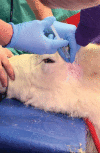Standing sedation management of a domesticated reindeer for third eyelid removal
- PMID: 37701662
- PMCID: PMC10495099
- DOI: 10.5455/OVJ.2023.v13.i8.11
Standing sedation management of a domesticated reindeer for third eyelid removal
Abstract
Background: Reindeer are becoming popular animals within petting farms. Few case reports describe the sedation of domesticated reindeer, but none describe the use of ocular local anesthetic blocks in this species.
Case description: A 9-year-old, female, Svalbard reindeer (Rangifer tarandus platyrhynchus) presenting for removal of a squamous cell carcinoma involving the third eyelid. Standing sedation was performed using initial boluses of medetomidine and butorphanol via intramuscular injection before catheter placement and maintenance with a variable rate infusion of medetomidine. Supraorbital, auriculopalpebral, infratrochlear blocks and local infiltration of the base of the third eyelid were performed using mepivacaine. Following the surgical removal of the third eyelid, atipamazole was administered intramuscularly to antagonize the effects of medetomidine. The patient recovered without complications.
Conclusion: Medetomidine-butorphanol in combination with local anesthetic blocks provided a sufficient plane of sedation and analgesia for extra ocular surgery in a domesticated reindeer.
Keywords: Anesthesia; Local anesthetic blocks for ophthalmic surgery; Ocular squamous cell carcinoma; Svalbard reindeer.
Conflict of interest statement
The authors declare no potential conflicts of interest with respect to the research, authorship, and publication of this article.
Figures





Similar articles
-
Physiologic evaluation of medetomidine-ketamine anesthesia in free-ranging Svalbard (Rangifer tarandus platyrhynchus) and wild Norwegian reindeer (Rangifer tarandus tarandus).J Wildl Dis. 2013 Oct;49(4):1037-41. doi: 10.7589/2013-03-049. J Wildl Dis. 2013. PMID: 24502737 Clinical Trial.
-
Reversible immobilization of free-ranging Svalbard reindeer (Rangifer tarandus platyrhynchus) with medetomidine-ketamine and atipamezole.J Wildl Dis. 2009 Jul;45(3):877-80. doi: 10.7589/0090-3558-45.3.877. J Wildl Dis. 2009. PMID: 19617505
-
Immobilization of Norwegian reindeer (Rangifer tarandus tarandus) and Svalbard Reindeer (R. t. platyrhynchus) with medetomidine and medetomidine-ketamine and reversal of immobilization with atipamezole.Acta Vet Scand. 1990;31(4):479-88. doi: 10.1186/BF03547531. Acta Vet Scand. 1990. PMID: 1983084 Free PMC article.
-
Effects of immobilization with medetomidine and reversal with atipamezole on blood chemistry of semi-domesticated reindeer (Rangifer tarandus tarandus L.) in autumn and late winter.Acta Vet Scand. 1999;40(4):335-49. doi: 10.1186/BF03547013. Acta Vet Scand. 1999. PMID: 10918903 Free PMC article.
-
Standing sedation and pain management for ophthalmic patients.Vet Clin North Am Equine Pract. 2004 Aug;20(2):485-97. doi: 10.1016/j.cveq.2004.04.005. Vet Clin North Am Equine Pract. 2004. PMID: 15271436 Review.
References
-
- Bouts T, Dodds J, Berry K, Arif A, Taylor P, Routh A, Gasthuys F. Detomidine and butorphanol for standing sedation in a range of zoo-kept ungulate species. J. Zoo. Wildl. Med. 2017;48(3):616–626. - PubMed
-
- Buck R.K, Meyer L.R.C, Stegmann G.F, Kästner S.B.R, Kummrow M, Gerlach C, Fosgate G.T, Zeiler G.E. Propofol–medetomidine–ketamine total intravenous anaesthesia in thiafentanil–medetomidine-immobilized impala (Aepyceros melampus) Vet. Anaesth. Analg. 2017;44(1):138–143. - PubMed
-
- Carroll G.L, Boothe D.M, Hartsfield S.M, Martinez E.A, Spann A.C, Hernandez A. Pharmacokinetics and pharmacodynamics of butorphanol in llamas after intravenous and intramuscular administration. J. Am. Vet. Med. Assoc. 2001;219(9):1263–1268. - PubMed
-
- Celly C.S, McDonell W.N, Young S.S, Black W.D. The comparative hypoxaemic effect of four α2 adrenoceptor agonists (xylazine, romifidine, detomidine and medetomidine) in sheep. J. Vet. Pharmacol. Ther. 1997;20(6):464–471. - PubMed
-
- de Henriksen M.L, Brooks D.E. Standing ophthalmic surgeries in horses. Vet. Clin. North. Am. Equine. Pract. 2014;30(1):91–110. - PubMed
Publication types
MeSH terms
Substances
LinkOut - more resources
Full Text Sources
